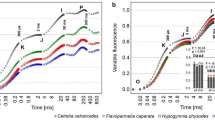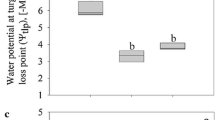Abstract
Lichens are unique phototrophic organisms whose physiology of stress tolerance attracts much attention. Parameters of photosynthetic and respiratory activities of the epiphytic large-leaved lichen Lobaria pulmonaria were investigated with an aim to reveal physiological responses to seasonal changes in environmental conditions. The highest accumulation of chlorophylls in thalli (2.3 mg/g dry wt) was noted in autumn (October); the amount of green pigments decreased 2.5 times in spring (April). The chlorophyll/carotenoid ratio varied from 3.1 to 4.4. The extent of deepoxidation of xanthophyll cycle pigments equaled 34% in winter but it was two times as low in summer. When L. pulmonaria thalli were hydrated and acclimated shortly under standard laboratory conditions, they exhibited a relatively high photochemical activity and were able to assimilate CO2 throughout the entire annual cycle. The rate of net CO2 uptake by thalli under optimal irradiance and temperature ranged from 3 to 5 µmol CO2/m2 s and the highest values were recorded in spring. No significant seasonal changes were observed in the total respiration rate of thalli. The proportions of various respiratory pathways were altered in spring and autumn, and metabolic heat production was accelerated due to the activation of an energetically low-efficient alternative respiratory pathway. The results provide evidence that the functional adaptation of photo- and mycobionts in the lichen is implicated in resistance of this complete system to seasonal changes in environmental conditions.




Similar content being viewed by others
REFERENCES
Honegger, R., Metabolic interactions at the mycobiont-photobiont interface in lichens, in Plant Relationships, Carroll, P.D.G.C. and Tudzynski, P.D.P., Eds., Berlin: Springer-Verlag, 1997, p. 209.
Manoilenko, K.V., Academician A.S. Famintsyn: from fundamental science to demands of agriculture, S-kh. Biol., 2010, vol. 45, p. 117.
Kappen, L. and Valladares, F., Opportunistic growth and desiccation tolerance: the ecological success of poikilohydrous autotrophs, in Handbook of Functional Plant Ecology, Pugnaire, F. and Valladares, F., Eds., New York: Marcel Dekker, 1999, p. 9.
Pystina, T.N., Lishainiki taezhnykh lesov Evropeiskogo Severo-Vostoka: podzony yuzhnoi i srednei taigi (Lichen of Taiga Forests of European Northeast: Subzone of Southern and Middle Taiga), Yekaterinburg: Ural. Otd., Ross. Akad. Nauk, 2003.
Beckett, R.P., Kranner, I., and Minibayeva, F.V., Stress physiology and the symbiosis, in Lichen Biology, Nash, T.H. III, Ed., 2nd ed., Cambridge: Cambridge Univ. Press, 2008, p. 134. https://doi.org/10.1017/CBO9780511790478.009
Yoshimura, I., Lung lichens and their vegetation in Japan and the other regions, in Lobarion Lichens as Indicators of the Primeval Forests of the Eastern Carpathians, Kondratyuk, S.Y. and Coppins, B.J., Eds., Kiev: Phytosociocentre, 1998, p. 53.
Golovko, T.K., Dal’ke, I.V., Dymova, O.V., Malyshev, R.V., Plyusnina, S.N., Pystina, T.N., Semenova, N.A., Tabalenkova, G.N., and Shelyakin, M.A., Functional ecology of the lichen Lobaria pulmonaria (L.) Hoffm. in taiga zone in the European North-East of Russia, Izv. Komi Nauchn. Tsentra, Ural. Otd., Ross. Akad. Nauk, 2018, vol. 3, p. 23.
Atlas Respubliki Komi po klimatu i gidrologii (Atlas of Komi Republic on Climate and Hydrology), Taskaev, A.I., Ed., Moscow: Drofa, 1997.
Dymova, O.V. and Kuzivanova, O.A., The optimization of extraction routine of photosynthetic pigments and its content in lichens thalli, Khim. Rastit. Syr’ya, 2018, vol. 2, p. 137. https://doi.org/10.14258/jcprm.2018023013
Jensen, M., Measurement of chlorophyll fluorescence in lichens, in Protocols in Lichenology: Culturing, Biochemistry, Ecophysiology and Use in Biomonitoring, Kranner, I.S., Beckett, R.P., and Varma, A.K., Eds., Berlin: Springer-Verlag, 2002, p. 135. https://doi.org/10.1007/978-3-642-56359-1_9
Rascher, U., Liebig, M., and Lüttge, U., Evaluation of instant light-response curves of chlorophyll fluorescence parameters obtained with a portable chlorophyll fluorometer on site in the field, Plant Cell Environ., 2000, vol. 23, p. 1397. https://doi.org/10.1046/j.1365-3040.2000.00650.x
Bahr, J.T. and Bonner, W.D., Cyanide-insensitive respiration I. The steady states of skunk cabbage spadix and bean hypocotyl mitochondria, J. Biol. Chem., 1973, vol. 248, p. 3441.
Muir, P.S., Shirazi, A.M., and Patrie, J., Seasonal growth dynamics in the lichen Lobaria pulmonaria, Bryologist, 1997, vol. 100, p. 458. https://doi.org/10.2307/3244407
Chakir, S. and Jensen, M., How does Lobaria pulmonaria regulate photosystem II during progressive desiccation and osmotic water stress? A chlorophyll fluorescence study at room temperature and at 77 K, Physiol. Plant, 1999, vol. 105, p. 257. https://doi.org/10.1034/j.1399-3054.1999.105210.x
Harańczyk, H., Bacior, M., and Olech, M.A., Deep dehydration of Umbilicaria aprina thalli observed by proton NMR and sorption isotherm, Antarct. Sci., 2008, vol. 20, p. 527. https://doi.org/10.1017/S0954102008001363
Schroeter, B. and Scheidegger, C., Water relations in lichens at subzero temperatures: structural changes and carbon dioxide exchange in the lichen Umbilicaria aprina from continental Antarctica, New Phytol., 1995, vol. 131, p. 273. https://doi.org/10.1111/j.1469-8137.1995.tb05729.x
Tretiach, M., Bertuzzi, S., Candotto Carniel, F., and Virgilio, D., Seasonal acclimation in the epiphytic lichen Parmelia sulcata is influenced by change in photobiont population density, Oecologia, 2013, vol. 173, p. 649. https://doi.org/10.1007/s00442-013-2654-3
Demmig-Adams, B., Carotenoids and photoprotection in plants: a role for the xanthophyll zeaxanthin, Biochim. Biophys. Acta, Bioenerg., 1990, vol. 1020, p. 1. https://doi.org/10.1016/0005-2728(90)90088-L
Pinnola, A., The rise and fall of light-harvesting complex stress-related proteins as photoprotection agents during evolution, J. Exp. Bot., 2019, vol. 70, p. 5527. https://doi.org/10.1093/jxb/erz317
MacKenzie, T.D., Król, M., Huner, N.P.A., and Campbell, D.A., Seasonal changes in chlorophyll fluorescence quenching and the induction and capacity of the photoprotective xanthophyll cycle in Lobaria pulmonaria, Can. J. Bot., 2002, vol. 80, p. 255. https://doi.org/10.1139/b02-005
Vráblíková, H., McEvoy, M., Solhaug, K.A., Barták, M., and Gauslaa, Y., Annual variation in photoacclimation and photoprotection of the photobiont in the foliose lichen Xanthoria parietina, J. Photochem. Photobiol. B, 2006, vol. 83, p. 151. https://doi.org/10.1016/j.jphotobiol.2005.12.019
MacKenzie, T.D., MacDonald, T.M., Dubois, L.A., and Campbell, D.A., Seasonal changes in temperature and light drive acclimation of photosynthetic physiology and macromolecular content in Lobaria pulmonaria, Planta, 2001, vol. 214, p. 57. https://doi.org/10.1007/s004250100580
Lange, O.L. and Green, T.G.A., Lichens show that fungi can acclimate their respiration to seasonal changes in temperature, Oecologia, 2005, vol. 142, p. 11. https://doi.org/10.1007/s00442-004-1697-x
McDonald, A.E. and Vanlerberghe, G.C., Origins, evolutionary history, and taxonomic distribution of alternative oxidase and plastoquinol terminal oxidase, Comp. Biochem. Physiol. Part D: Genomics Proteomics, 2006, vol. 1, p. 357. https://doi.org/10.1016/j.cbd.2006.08.001
van Dongen, J.T., Gupta, K.J., Ramírez-Aguilar, S.J., Araújo, W.L., Nunes-Nesi, A., and Fernie, A.R., Regulation of respiration in plants: a role for alternative metabolic pathways, J. Plant Physiol., 2011, vol. 168, p. 1434. https://doi.org/10.1016/j.jplph.2010.11.004
Shelyakin, M.A., Zakhozhii, I.G., and Golovko, T.K., Changes of total respiration and respiratory pathways ratio in lichens adaptation to UV-B radiation, Izv. Ufimsk. Nauchn. Tsentra, Ross. Akad. Nauk, 2018, vol. 3, p. 100.
Shelyakin, M., Zakhozhiy, I., and Golovko, T., The effect of temperature on Antarctic lichen cytochrome and alternative respiratory pathway rates, Polar Biol., 2020, vol. 43, p. 2003. https://doi.org/10.1007/s00300-020-02758-4
Maxwell, D.P., Wang, Y., and McIntosh, L., The alternative oxidase lowers mitochondrial reactive oxygen production in plant cells, Proc. Natl. Acad. Sci. U.S.A., 1999, vol. 96, p. 8271. https://doi.org/10.1073/pnas.96.14.8271
Joseph-Horne, T., Hollomon, D.W., and Wood, P.M., Fungal respiration: a fusion of standard and alternative components, Biochim. Biophys. Acta, Bioenerg., 2001, vol. 1504, p. 179. https://doi.org/10.1016/S0005-2728(00)00251-6
Beckett, R.P., Alyabyev, A.J., and Minibayeva, F.V., Patterns of heat production during desiccation and rehydration in lichens differing in desiccation tolerance, Lichenologist, 2011, vol. 43, p. 178. https://doi.org/10.1017/S0024282910000769
ACKNOWLEDGMENTS
We are grateful to Candidate of Science M.S. Khristin (Institute of Basic Biological Problems, Russian Academy of Sciences, Pushchino) for help with measurements of low-temperature fluorescence spectra on L. pulmonaria thalli.
Funding
This work was supported by the state budget assignment for research and development, project no. AAAA-A17-117033010038-7 Physiology and Stress Resistance of Photosynthesis in Plants and Poikilohydric Photoautotrophs in Conditions of the North.
Author information
Authors and Affiliations
Corresponding author
Ethics declarations
Conflict of interests. The authors declare that they have no conflicts of interest.
Statement on the welfare of humans or animals. This article does not contain any studies involving animals performed by any of the authors.
Additional information
Translated by A. Bulychev
Abbreviations: AP—alternative respiratory pathway; Car—carotenoids; Chl—chlorophyll; CP—cytochrome respiratory pathway; DEPS—deepoxidation state of violaxanthin cycle pigments; ETC—electron transport chain; PPFD—photosynthetic photon flux density; PSI—photosystem I; PSII—photosystem II; PSA—photosynthetic apparatus; RH—relative humidity; VXC—violaxanthin cycle.
Rights and permissions
About this article
Cite this article
Shelyakin, M.A., Zakhozhiy, I.G., Dalke, I.V. et al. Photosynthetic and Respiratory Capacity of Foliose Lichen Lobaria pulmonaria throughout the Annual Cycle. Russ J Plant Physiol 68, 1048–1058 (2021). https://doi.org/10.1134/S1021443721060182
Received:
Revised:
Accepted:
Published:
Issue Date:
DOI: https://doi.org/10.1134/S1021443721060182




